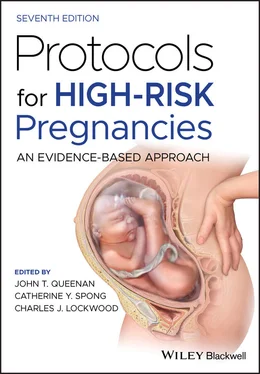1 ...8 9 10 12 13 14 ...38 5 Arrange follow‐up. Smoking status should be monitored throughout pregnancy, providing opportunities to congratulate and support success, reinforce steps taken toward quitting, and advise those still considering a cessation attempt.
Pharmaceutical tobacco smoking cessation aids such as nicotine replacement therapy (NRT), varenicline, or bupropion SR are efficacious as first‐line agents in the general nonpregnant population. The use of these medications is not yet routinely recommended in pregnancy , as there are inconclusive data on their effectiveness and safety. NRT is available as transdermal patch, inhaler, nasal spray, chewing gum, or lozenge. Most existing data for smoking cessation in pregnancy are based on NRT delivery methods such as patches, but a randomized clinical trial (RCT) comparing nicotine inhalers and placebo for pregnant smokers was recently published. This RCT showed no benefit of nicotine inhalers for smoking cessation in pregnancy, although there was notably a lower rate of preterm birth if the woman used the nicotine inhaler compared to placebo. In general, NRT should be used with extreme caution and women should be warned of uncertain side effects in pregnancy.
Bupropion SR is an atypical antidepressant that has been approved by the FDA for use in smoking cessation. It is contraindicated in patients with bulimia, anorexia nervosa, use of MAO inhibitors within the previous 14 days, or a known or history of seizure disorder. It carries a black box warning due to an association of antidepressant medications with suicidality in children, adolescents, and young adults under the age of 24 years. Varenicline is approved for smoking cessation in the general population. Serious neuropsychiatric symptoms have been associated with its use including agitation, depression, and suicidality. Although there have been several small studies performed evaluating the safety of varenicline in pregnancy with no evidence of teratogenicity documented, these data must be interpreted with caution.
To date, contingency management, or the use of tangible reinforcement to promote desired behaviors, is the most promising technique to achieve smoking cessation and has been shown to be an effective motivational tool for overcoming other addictions, including alcohol and substance abuse.
An increasing proportion of smokers are now using e‐cigarettes, either for nicotine delivery or as a measure to assist with smoking cessation. Although e‐cigarettes may contain fewer harmful substances than cigarettes, they are not considered safe to use during pregnancy. In addition to the impact of the nicotine administered, there are some flavorings that may be harmful to the developing fetus. It should be noted that at this time, the Centers for Disease Control and Prevention (CDC) recommend against the use of e‐cigarette products given the risks associated with such use.
Tobacco use not only impacts the health of the mother and fetus but carries over into the postnatal period. Pregnancies among women who smoke cigarettes have been associated with increased risks for miscarriage, ectopic pregnancy, fetal growth restriction, placenta previa, abruptio placentae, preterm birth, premature rupture of the membranes, and low birthweight. In a recent metaanalysis reviewing 142 studies, any smoking during the pregnancy increased the risk of stillbirth by approximately 50% and risk of neonatal death by 20%. There appears to be a dose–response relationship, with heavy smokers having the greatest risk.
The offspring of smoking mothers face additional risks during childhood. There is a strong association between maternal smoking and sudden infant death syndrome, and again, a clear dose–response relationship has been demonstrated. Prenatal and postnatal tobacco smoke exposure has also been associated with increased risk of reduced lung function, respiratory infections, and asthma in the children. Recent studies suggest that infants born to women who smoke during pregnancy may be at increased risk for childhood obesity, as well as other metabolic dysfunctions, likely through a developmental programming effect. In addition, there is evidence suggesting a neurotoxic effect of prenatal tobacco exposure on newborn behavior, i.e., being more excitable and hypertonic. The behavioral and cognitive deficits associated with in utero exposure to tobacco seem to continue into late childhood and adolescence with increased risk for attention‐deficit hyperactivity disorder and conduct disorder.
In addition to nicotine exposure, e‐cigarette use has been associated with an additional risk. An acute, severe respiratory distress syndrome has been identified in individuals using e‐cigarette products. Over 2000 e‐cigarette or vaping product use‐associated lung injury (EVALI) events were reported by the CDC in the US in 2019. The exact etiology of the lung injury is unknown but vitamin E acetate exposure may play a role in the development of EVALI. Pregnant women are at higher risk for severe outcomes with EVALI, therefore these products should not be used in pregnancy.
Many pregnant women can remain smoke free during their pregnancy but postnatal relapse rates are high. The Pregnancy Risk Assessment Monitoring System reported relapse rates as high as 67% at greater than six months postpartum. Counseling should be continued at each postpartum visit including unequivocal, personalized and positive messages about the benefits to the patient, her baby and family resulting from smoking cessation. Although available data are limited, pharmacotherapy can be considered for the lactating woman. Any potential risk for the nursing infant from passage of small amounts of the medications through breast milk should be weighed against the increased risks associated with second‐hand exposure to smoking such as sudden infant death syndrome, respiratory infections, asthma, and middle ear disease.
1 American College of Obstetricians and Gynecologists. Smoking cessation during pregnancy. Committee Opinion No. 721. Obstet Gynecol 2017; 130:e200–4.
2 Blunt BC, Karwowski MP, Shields PG, et al. Vitamin E acetate in bronchoalveolar‐lavage fluid associated with EVALI. N Engl J Med 2020; 382:697–705
3 Curtin SC, Matthews TJ. Smoking prevalence and cessation before and during pregnancy: fData from the birth certificate, 2014. Natl Vital Stat Rep 2016; 65:1–14.
4 Jatlaoui TC, Wiltz JL, Kabbani S, et al. Update: interim guidance for health care providers for managing patients with suspected e‐cigarette, or vaping, product use – associated lung injury – United States, November 2019. MMWR 2019; 68:1081–6.
5 Kapaya M, d’Angelo DV, Tong VT, et al. Use of electronic vapor products before, during, and after pregnancy among women with a recent live birth – Oklahoma and Texas, 2015. MMWR 2019; 68;189–94.
6 Layden JE, Ghinai I, Pray I, et al. Pulmonary illness related to e‐cigarette use in Illinois and Wisconsin – final report. N Engl J Med 2020; 382:903–16.
7 Likis FE, Andrews JC, Fonnesbeck CJ, et al. Smoking Cessation Interventions in Pregnancy and Postpartum Care. Evidence Report/Technology Assessment No. 214. (Prepared by the Vanderbilt Evidence‐based Practice Center under Contract No. 290‐2007‐10065‐I.) AHRQ Publication no. 14‐E001‐EF. Rockville, MD: Agency for Healthcare Research and Quality, 2014. www.effectivehealthcare.ahrq.gov/reports/final.cfm
8 Shahab L, Goniewicz ML, Blount BC, et al. Nicotine, carcinogen, and toxin exposure in long‐term e‐cigarette and nicotine replacement therapy users: a cross‐section study. Ann Intern Med 2017; 166:390–400.
9 Tong VT, Dietz PM, Morrow B, et al. Trends in smoking before, during, and after pregnancy – Pregnancy Risk Assessment Monitoring System, United States, 40 sites, 2000–2010. MMWR Surveill Summ 2013; 62:1–19.
Читать дальше












